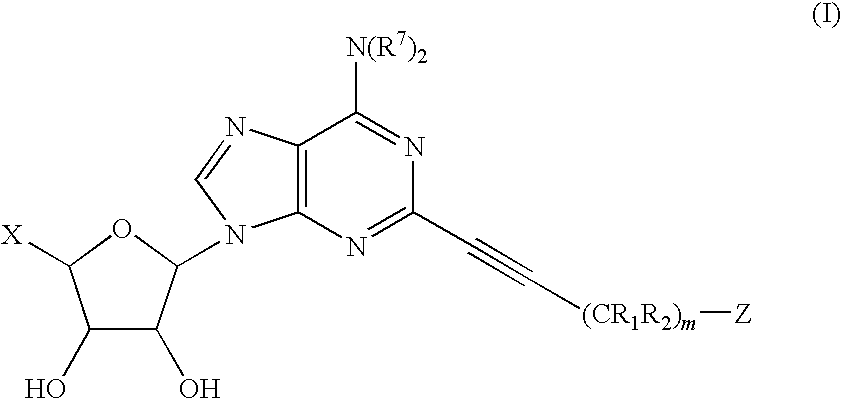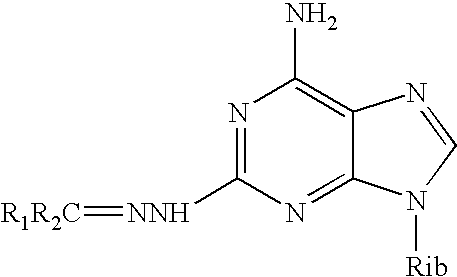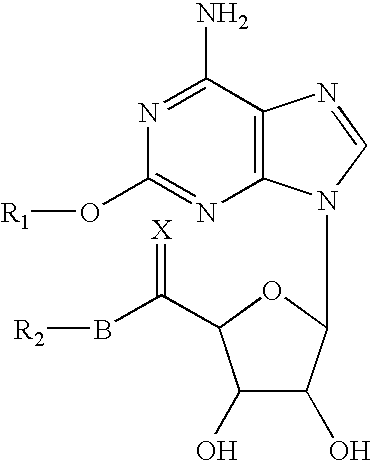2-polycyclic propynyl adenosine analogs having A2A agonist activity
a technology of polycyclic propynyl adenosine and agonist activity, which is applied in the direction of biocide, anti-inflammatory agents, drug compositions, etc., can solve the problems of side effects and inappropriate injury to host tissues, and achieve the effects of reducing morbidity and mortality, improving outcome, and promoting oxidative stability
Active Publication Date: 2009-08-18
UNIV OF VIRGINIA ALUMNI PATENTS FOUND +1
View PDF115 Cites 34 Cited by
- Summary
- Abstract
- Description
- Claims
- Application Information
AI Technical Summary
Benefits of technology
"The present invention provides compounds and methods for inhibiting inflammation in mammalian tissue caused by various factors such as pathological agents, physical, chemical, or thermal trauma, or medical procedures. The compounds are novel 2-alkynyladenosine derivatives with specific polycyclic moieties attached. The invention has a broad range of applications in protecting tissue from inflammation and promoting healing."
Problems solved by technology
The body's response becomes an agent of disease when it results in inappropriate injury to host tissues in the process of eliminating the targeted agent, or responding to a traumatic insult.
However, R-PIA and Cl-Ado analogs are actually more potent activators of A1 adenosine receptors than of A2A adenosine receptors and, thus, are likely to cause side effects due to activation of A1 receptors on cardiac muscle and other tissues causing effects such as “heart block.”
Method used
the structure of the environmentally friendly knitted fabric provided by the present invention; figure 2 Flow chart of the yarn wrapping machine for environmentally friendly knitted fabrics and storage devices; image 3 Is the parameter map of the yarn covering machine
View moreImage
Smart Image Click on the blue labels to locate them in the text.
Smart ImageViewing Examples
Examples
Experimental program
Comparison scheme
Effect test
example 1
5-[6-Amino-2-(2-hydroxy-bicyclo[2.2.1]hept-2-ylethynyl)-purin-9-yl]-3,4-dihydroxy-tetrahydro-furan-2-carboxylic acid cyclopropylamide
[0333]
example 2
5-[6-Amino-2-(2-hydroxy-bicyclo[2.2.1]hept-2-ylethynyl)-purin-9-yl]-3,4-dihydroxy-tetrahydro-furan-2-carboxylic acid cyclopropylamide
[0334]
example 3
5-[6-Amino-2-(2-hydroxy-adamantan-2-ylethynyl)-purin-9-yl]-3,4-dihydroxy-tetrahydro-furan-2-carboxylic acid cyclopropylamide
[0335]
the structure of the environmentally friendly knitted fabric provided by the present invention; figure 2 Flow chart of the yarn wrapping machine for environmentally friendly knitted fabrics and storage devices; image 3 Is the parameter map of the yarn covering machine
Login to View More PUM
| Property | Measurement | Unit |
|---|---|---|
| temperature | aaaaa | aaaaa |
| temperature | aaaaa | aaaaa |
| pH | aaaaa | aaaaa |
Login to View More
Abstract
The invention provides compounds having the following general formula (I):wherein X, R1, R2, R7 and Z are as described herein.
Description
RELATED APPLICATIONS[0001]This application claims priority from a provisional application entitled: “2-POLYCYCLIC PROPYNYL ADENOSINE ANALOGS WITH MODIFED 5′-RIBOSE GROUPS HAVING A2A AGONIST ACTIVITY”, filed on Aug. 2, 2004, Ser. No. 60 / 598,184, the entire contents of which is included herein by reference.GOVERNMENT FUNDING[0002]The invention described herein was made with government support under Grant Number (RO1-HL37942), awarded by the National Institutes of Health. The United States Government has certain rights in the invention.BACKGROUND OF THE INVENTION[0003]The inflammatory response serves the purpose of eliminating harmful agents from the body. There is a wide range of pathogenic insults that can initiate an inflammatory response including infection, allergens, autoimmune stimuli, immune response to transplanted tissue, noxious chemicals, and toxins, ischemia / reperfusion, hypoxia, mechanical and thermal trauma. Inflammation normally is a very localized action, which serves ...
Claims
the structure of the environmentally friendly knitted fabric provided by the present invention; figure 2 Flow chart of the yarn wrapping machine for environmentally friendly knitted fabrics and storage devices; image 3 Is the parameter map of the yarn covering machine
Login to View More Application Information
Patent Timeline
 Login to View More
Login to View More Patent Type & Authority Patents(United States)
IPC IPC(8): A01N43/04A61K31/70
CPCC07H19/16A61K51/0491A61P29/00
Inventor RIEGER, JAYSON M.LINDEN, JOEL M.MACDONALD, TIMOTHY L.SULLIVAN, GAIL W.MURPHREE, LAUREN J.FIGLER, ROBERT ALANTHOMPSON, ROBERT DOUGLAS
Owner UNIV OF VIRGINIA ALUMNI PATENTS FOUND
Features
- R&D
- Intellectual Property
- Life Sciences
- Materials
- Tech Scout
Why Patsnap Eureka
- Unparalleled Data Quality
- Higher Quality Content
- 60% Fewer Hallucinations
Social media
Patsnap Eureka Blog
Learn More Browse by: Latest US Patents, China's latest patents, Technical Efficacy Thesaurus, Application Domain, Technology Topic, Popular Technical Reports.
© 2025 PatSnap. All rights reserved.Legal|Privacy policy|Modern Slavery Act Transparency Statement|Sitemap|About US| Contact US: help@patsnap.com



